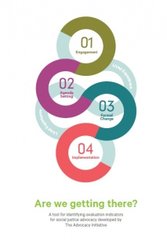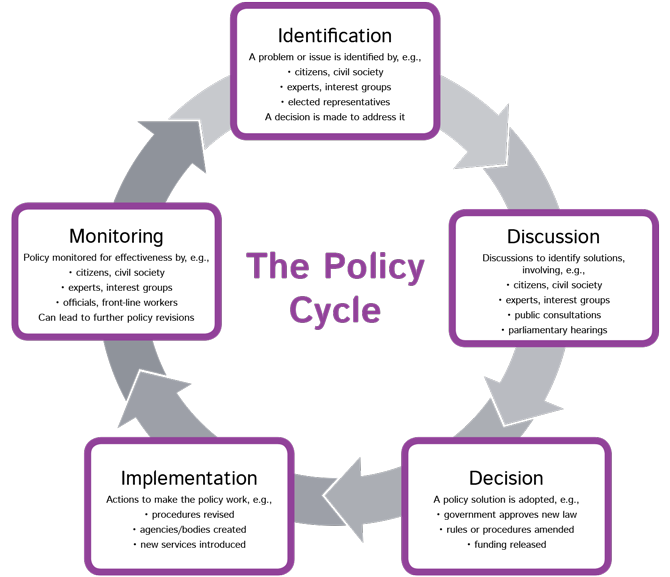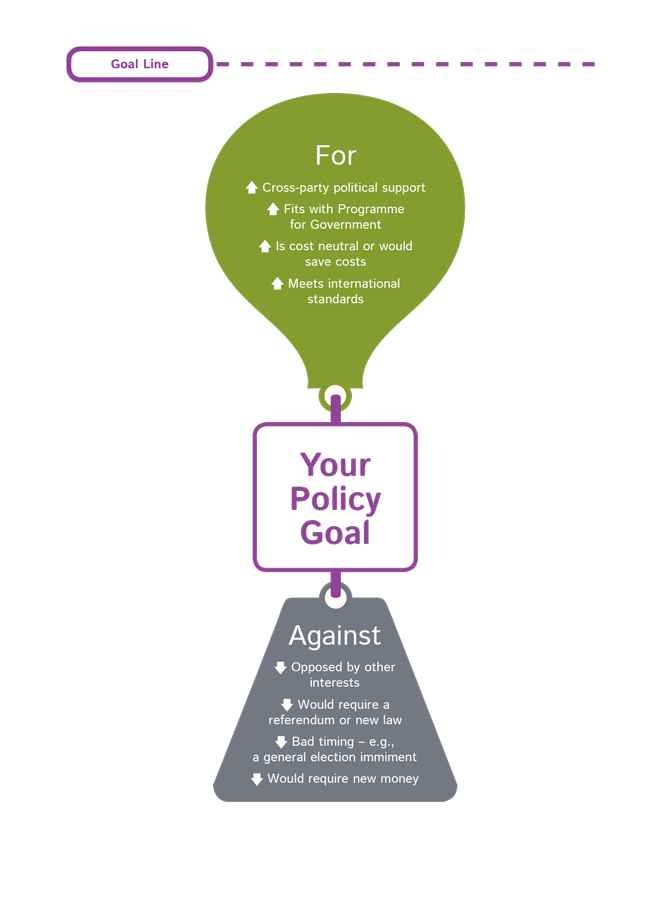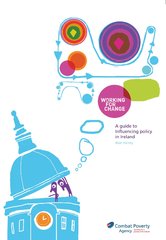
Policy-Making
Public policy is about answering needs and finding solutions to problems in our society.
This guide will help you to access the main sources of information to make it easier to understand current public policies.
It will also help you identify who has the power to change policy in your area of interest, and how to influence them.
Find on this page
Understanding public policy
Public policy is what governments, local authorities and other public bodies do about problems or issues that affect the country, a locality, individuals or groups of people in society.
It can be difficult to understand policy-making in abstract terms. Sometimes there is an overall policy statement or strategy. In other cases, we can find out what policy is in any given area by looking at a range of government and public agency activities, including:
- new or revised laws and regulations
- funding plans for public services, such as education, health or social welfare, including the annual Budget
- investments in physical infrastructure such as roads or hospitals
No one has a complete picture of all public policy. Experts in certain major policy areas, like health or education for example, have built up knowledge of how policies have changed over time.
'Policy' can be a slippery term. Among other things, it can mean promises in political party manifestos, genuine intent of a government or public agency (without a thought-out strategy), concrete actions, and specific short or long-term goals. In order to be implemented, many policies require laws to be passed. You can find out more about how this works in the Toolkit Guide to Law Making.
Ongoing policies

This can be seen as a policy of maintaining the status quo.
For example, successive governments have pursued the broad policy goal of seeking to reduce the toll of deaths on our roads. The Road Safety Authority, which implements policy in this area, may from time to time revise its approach to implementation of this policy goal, based on research or budgets.
Sometimes governments take office with a commitment to change policy in a particular area, such as education or income tax. Also, if a controversy arises, a government may decide to dramatically change existing policies.
Sometimes there is a lack of action in a particular policy area. There can be many reasons for this. They could include funding problems, political or public opposition to certain proposals, personnel shortages, or the fact that there are other more pressing priorities.
Sometimes a decision to ‘do nothing’ is the government’s policy, although it may not ever be stated in this way.
Getting started - finding out about policy in your area
It can often take time and effort to identify the current intention (or policy) of government with respect to a given topic or issue, along with what is actually being done to implement the policy.
Given the diversity of government departments and public service bodies, it should be no surprise that there is often not a single stream of centralised information about policy in a particular area.
A good deal of official information is available on the websites of various government departments and public bodies. These also have information offices, which handle inquiries. Sometimes what is available can show gaps or contradictions in policy across government departments or public bodies. But this may also show the complexity of the policy system.
Policy-making can be complex, and there is often no alternative to investing time in reading about a policy area. This requires access to the internet, newspaper archives and possibly public or university libraries.
Where you can read policies
Key sources for identifying ‘policy’ on a particular topic are:
- the Programme for Government, effectively a government’s ‘work plan’ for its period in office. These are typically based on political parties’ pre-election manifesto promises. Programmes for Government change when new governments take office. Read the current Programme for Government.
- the Budget, this shows in money terms the government’s commitment to certain policies.
- national plans from government departments or public bodies or agencies, which often set out targets, objectives and performance indicators.
- laws and regulations including Acts of the Oireachtas and secondary legislation or statutory instruments.
- government department consultation papers and proposals, including Green Papers and White Papers.
- government circulars which provide information, guidance, rules, and/or background information on policy or procedural matters, such as those issued by the Health Service Executive.
- parliamentary statements made by government Ministers, including answers to Parliamentary Questions.
- media statements made by government Ministers, or announcements in official press releases or speeches, including the regular stream of announcements from the Government Press Office, www.merrionstreet.ie .
- reports or analysis by public agencies.
- reports or analysis from international bodies, like the EU, the UN or the OECD.
- reports or analysis by the media around a given topic or issue, including social media and alternative media.
- academic books or papers with up-to-date reviews of a topic or issue.
- published research or analysis of a topic by activists or interest groups.
- official statistics, including public spending data.
- testimony by people who have first-hand experience of issues (this information may be reported in the media or available via community organisations).
All of these sources can help you find out both the government’s intention, and the existing situation on the ground. But it is very important to remember that some may also may be biased either in favour of or against existing policy, or may lack some crucial information.
Where is policy being discussed?
Government policy is constantly under discussion. Here are some ways to keep up to date with policy in an area that interests you:
- Get in contact with organisations already campaigning on an issue you are interested in, or which are working in a related area.
- Attend talks and seminars can be valuable, both in terms of hearing discussions, but also to identify experts, public officials and interested parties on a given topic.
- Sign up for updates or events hosted by think-tanks and representative organisations, such as trade unions or employers’ groups. These can be useful sources of expertise.
- For deeper research you may also find it useful to learn about the main academic interpretations of a policy issue, as well as alternative responses to address it.
- Blogs and websites of research institutes, government departments, non-governmental organisations and media outlets are also useful sources for ongoing information and analysis on policy developments.
- Attend or watch on television Oireachtas debates and committee hearings.
Policy in action – from paper to practice
The policy: The Action Plan for Jobs from the Department of Jobs, Enterprise and Innovation.
The policy goal: Full employment: 2.1m people in work by 2018.
The policy ‘tools' in 2015 include:
- A Low Pay Commission to undertake analysis and make a recommendation on the appropriate level of the national minimum wage.
- More than 6,000 free places in higher education courses for job-seekers.
- New apprenticeships in response to proposals from key sectors of the economy.
- A Pathways to Work Strategy developed by the Department of Social Protection to compliment the Action Plan for Jobs.
Mind the gap - implementation is key
It can sometimes be difficult to find out what official public policy is on a particular topic. This is because some policy is informal, or at least unwritten. Even when something is stated in writing as a matter of formal public policy, it doesn’t mean that’s how it works in real life.
How policy is actually implemented in practice can be different to the written intention of government or a public body. Shortcomings or loopholes between formal policies and how things work in practice are sometimes referred to as implementation gaps.
There is also the question of how much effort, emphasis, and funding is given to any single policy, among the many policy priorities that governments and public bodies have to balance.
The competence and 'buy in' of key personnel in the public service can play a decisive role in how effectively and how quickly policy change is implemented.
Policy as facts on the ground
Many groups which campaign for change take the pragmatic view that ‘policy' is what is actually happening on the ground, rather than what may be contained in a formal document.
For example, official government policy may state that that every school child with special educational needs should get certain supports.
If the reality is that only some pupils get the supports that they are entitled to, then we can say that government policy is not working properly.
This could be due to various reasons such as a staff shortages, a lack of allocated funding or even problems in how children with special needs are assessed for the supports.
Individuals and organisations who come across policy shortcomings or implementation gaps on a daily basis can put this experience to good use by bringing problems to the attention of policy-makers. Many groups working for change also often try to come up with workable suggestions as to how improvements can be made.
Individuals can also complain about public services through internal complaints channels, to regulators or to the Ombudsman.
For more on how this works, see the Toolkit Guide to Citizen Watchdogs.
From Programme for Government to policy delivery
Public policy commitments outlined in a Programme for Government may be tweaked or significantly changed when it comes to delivering them.
This can be for various reasons – maybe because what was pledged was impractical, or there are legal difficulties with it, or funding cuts mean it is not possible to deliver the original commitment.
Find on this page
Policy is constantly evolving
There is no simple formula that sums up the complex process of how policy is made. Policy is constantly being shaped and re-shaped by Ministers, civil servants, political parties, public bodies, interest groups, activists, public opinion and the media. If you want to change policy, you need to work out who has the power or influence to bring about the changes you seek.
Stages in the policy cycle
There are five key stages that policy-makers generally go through in identifying areas of policy that deserve their attention and addressing them. These are part of what can be called the policy cycle. These are summarised in the Policy Cycle graphic below. Here they are:
1. An issue or problem is identified
A significant public problem or issue is recognised by policy-makers and a decision in principle is made to tackle it. This first stage of getting your issue or problem on the policy-making agenda can be difficult and time consuming. Individual citizens, parliamentarians, civil society, interest groups, experts and the media often play a role in bringing issues or problems to the attention of policy-makers.
2. Policy options are discussed
If you are seeking to influence policy-making, this is a key stage when officials and public representatives will engage with experts, non-governmental groups and others to find a solution. It is important to have a clear and well-thought-out idea of the policy change you seek.
3. Decision to adopt a policy solution
A particular policy solution is formally adopted. This might require political negotiations or approval for new laws or changes in rules or guidance issued by government, public bodies, or local authorities. It could also require approval for new structures or bodies to be established, or new funding streams to be put in place.
4. New policy is implemented
Steps are taken to put the new policy in place. This could include the enactment of a new or revised law, the setting up of a new organisation, the allocation of new public funding, or the introduction of new public services.
5. Policy is monitored
Shortcomings may emerge in the new policy, or in how it is implemented. These new problems may then be identified and added to the policy agenda, with the cycle starting again, and the existing policy revised or replaced. This might be a formal review process. But equally policy can evolve as feedback is received from the public and from those implementing it.
The policy cycle - graphic
It's complicated - the reality of policy-making
While it helps to break policy-making into these five separate stages, in reality the process is not nearly so clear cut or rational.
For a start, policy-makers rarely start with a blank canvas; for many problems or issues identified, a policy is probably already in place. For example, to change an employment related policy could affect working conditions and lead to negotiations with trade unions.
Also, many problem situations don’t have a single correct answer.
Policy-makers have to make choices about which solution to choose. These may be heavily influenced by many factors, including lobbying by outside groups and the standpoint of organisations who need to be persuaded to change.
Crisis policy-making - seizing opportunities
Sometimes, drastic or fundamental policy changes can take place rapidly. This is usually what happens when a public crisis erupts that forces policy-makers to respond quickly to a problem that has until then been 'below the radar’.
In such circumstances, the policy-making process is often short-circuited, and the five policy cycle stages can take place in a short period of time.
For example, the tragic death of a homeless man in Dublin in 2014 led Ministers to hastily introduce a range of policy measures to accelerate and augment measures already in place to address the problem of people sleeping rough.
Such incidents, while tragic, can be crucial in unlocking additional resources or getting a greater share of a government's limited time and attention.
Groups or individuals working for change should be prepared to seize the opportunity presented by a crisis to present their solutions to policy-makers.
Similarly, sustained public or political opposition can lead to dramatic policy shifts. For example, the Irish government’s policy in relation to household charges for water usage changed in 2014 in response to widespread public protests.
Policy-making and the art of the possible
Many policies are a compromise between the best technical solution and the solution that politicians, interest groups and the public will accept.
These choices are always framed by the balancing act of trying to meet many different demands from the same limited pool of resources.
Sometimes policy-makers do not have the resources or expertise to assess all of the policy options available to them before making a choice between alternatives.
Or they may lack sufficient data to make anything more than incremental changes in existing policy, on a trial and error basis.
Who are the policy-makers?

In reality, this is an over-simplification which does not capture the complexities of how policy is formulated, implemented and evaluated.
Depending on your issue, the relevant decision-maker could be a Minister, a civil servant, a county manager, the head or board of a public body, or a health board official. Sometimes a range of people may need to come together to make a decision.
There are few a hundred people in the 'top tier' of decision-making in central government in Ireland. On an almost daily basis, they make important decisions that affect us all. These are:
The Government/Cabinet
Any significant policy changes, and some minor ones, must be approved by the government. The government is headed by the Taoiseach and made up of Ministers who are in charge of government departments. The government generally meets once a week (at Cabinet meetings usually held on Tuesdays) to discuss and approve major proposals from Ministers and their departments.
Government Ministers
As political leaders of government departments, Ministers steer policy in a particular direction in their own areas. Each Minister is in charge of at least one government department. Rarely, some may run more than one department. Formal decisions to implement a new policy or review current policy are taken by Ministers, who have considerable autonomy when running their own departments.
When it comes to certain matters, like the introduction of draft laws, Ministers need to get government approval at the weekly Cabinet meeting before acting to implement policy.
Government approval for policy decisions is even more important in coalition governments made up of different political parties. Any proposal to spend additional resources requires agreement from the Minister for Finance and/or the Minister for Public Expenditure.
Senior civil servants
Senior civil servants – at Principal Officer level and above – play a lead role in developing policies, strategies, and plans. It is their job to gather, distil and present information for Ministers and to maintain contacts with stakeholders both within the civil service and outside it.
They also commission or conduct policy research and manage the setting up of expert or advisory groups. Civil servants at this level may also work closely with the wider public service and state-owned or state-funded bodies.
Civil servants are often referred to as 'the permanent government'. While elected ministers do not usually stay more than a few years in one department, civil servants can remain in their posts for lengthy periods.
For example, T.K. Whitaker was the chief civil servant in the Department of Finance in the 1950s and 1960s, and played a pivotal role in the country’s economic development.
You can also find names and contact details of senior civil servants in government departments and some state bodies on the government website, Who Does What.ie
Special advisers
Each Minister has at least one special adviser. These are often, but not always, employed from outside the public service. They can play a number of distinct roles, depending on what the Minister seeks.
For example, some may be policy experts in a particular area, while others advise Ministers on the political aspects of government policy decisions or actions. Special advisers can be influential in steering policy and ensuring that a Ministers’ priorities are consistently pursued by the department.
They liaise with the key civil servants in departments as well as outside interest groups and individuals. Special advisers (along with civil servants) often accompany their Ministers at significant official events. While special advisers are an important link to their ministers, their names and faces are often not known outside of political and media circles.
You may be able to find the names and contact details of special advisers on the websites of some, but not all, government departments. They are generally listed in the Institute of Public Administration’s Annual Directory, which you can purchase.
Since September 2015, all government departments must publish the names of Ministerial advisers and senior civil servants on their websites. They are also listed on the lobbying regulation website, www.lobbying.ie.
Public body officials
Staff and board members in hundreds of public bodies manage public services and devise and implement strategies, policies and rules. They include the Communications Regulator, ComReg, the Competition and Consumer Protection Commission, the Food Safety Authority and the Censorship of Publications Board.
TDs and Senators
Elected members of the Dáil and Seanad play an important role in the policy-making process. For more on their role, see the Toolkit Guide to Law-Making.
The civil service policy-shapers
The top echelons of civil servants in government departments play a vital role in policy development. They are charged with summarising and filtering information and developing policy options for Ministers and the government.
- Each government department is led by a Secretary General, who is the chief policy adviser to the minister. There are currently 17 Secretaries General.
- Assistant Secretaries make up the senior management team of government departments. There are currently 143 Assistant Secretaries.
- Principal Officers and Assistant Principals are the key policy development and policy management tier of government departments. They are often specialists in particular policy areas. There are currently 2,600 civil servants at these grades.
Find on this page
Influencing policy
There is no one-size-fits-all approach to influencing policy. Often there are many centres of influence and it may take some time to find out who are the key players in a particular area.
Also, strategies or approaches that prove successful in one area might have no effect in another. Ultimately, securing change involves somehow convincing policy-makers that doing nothing is not an option.
Creating the right climate in favour of the change you want is crucial. This may involve working and building relations with different bodies and individuals.
This section of the guide focuses on some of the main ways to influence policy-making at national government level.
You may also find the Toolkit Guides to Law-Making, Local Government and the European Union useful.
Getting involved in public policy decision-making
There are a variety of ways for groups and individuals to get involved in policy-making, both formal and informal. The main formal channels are through advisory groups or consultations.
Advisory groups
Government departments and public bodies seek policy advice from a range of specialist bodies, including temporary working groups, taskforces or committees. Their job is to examine an issue and report back within a certain period of time. These groups are usually appointed by a public body or a Minister and include civil or public servants as well as external participants who generally either have expertise in the area under scrutiny or represent particular stakeholders.
Traditionally, if you were not already ‘in the know’ it was difficult to be considered for membership of an advisory group. This was because positions were generally not advertised in advance.
However, there are now more open calls for participants to take part in advisory groups. For example, the Department of Jobs, Enterprise and Innovation in 2015 issued a public call for qualified people to apply for membership of an advisory body set up to look at minimum pay. There are also regular calls for people to join the boards of state bodies. You can sign up for alerts of vacanices on state boards via the official Stateboards website.
Consultations
Many government departments, public bodies and local authorities regularly organise consultations on policy areas with the public or interested stakeholders.
For example, the Department of Social Welfare runs public meetings, roadshows, customer panels and budget forums, while the Department of Education has set up dedicated phone lines to handle feedback on policy proposals.
Notices for these will generally be placed on the websites of the relevant bodies. Some government departments and local authorities that run regular consultations even have special ‘consultation’ sections on their websites.
However, the approach to consultations is not set in stone and there are considerable variations between how different departments or public bodies invite groups and individuals to provide input into policy-making. The best way to stay up to date is to regularly check their websites and keep in touch with officials.
Degrees of influence in policy-making
Policy-makers routinely invite input from groups and individuals. However, this does not mean that there is an even playing field when it comes to influencing policy.
The degree of influence that different players and interest groups enjoy can depend on many factors. These include the size of the organisation seeking the policy change
and the number of people likely to be affected positively and negatively by any change in policy.
Social status, professional background, communication skills, and formal or informal connections within the decision-making and political system are also key factors when it comes to influencing policy.
Ways to influence public policy ‘from the outside'
Sometimes policy decision-makers are unwilling to listen directly to outside groups or individuals. Sometimes, they may be constrained in what they can do because of other opposing forces or considerations.
If these types of cases, it can help to put indirect pressure on decision-makers by taking your message to other audiences which can in turn help influence them.
There are many different tactics that groups and individuals routinely use to convince policy-makers to act. Which one to use will depend on many factors, including the nature of the policy change that you seek and your own skills and available resources.
Some of the most common approaches to influencing policy from the outside are:
- Campaigning
- Lobbying
- Research
- Legal Action
- Media work
This guide outlines the key elements of these approaches, as well as the pros and cons involved in them. It also includes some examples of how these approaches have been used successfully to change policy. Often, more than one of these approaches may be needed to achieve policy changes.
Campaigning
Campaigning can take many forms. It includes organised letter writing, email or social media campaigns, street protests, vigils, demonstrations, and sleep-outs.While these sorts of activities will generally not deliver policy changes in themselves, they can be a very effective part of a broader effort that may also include other activities.
Many campaigning groups put a lot of creative energy into street events outside government departments, public buildings or Leinster House, the seat of parliament.
The more imaginative and eye-catching the activity, the more chance you will have of getting media coverage, and also the attention of politicians and ministers, who are often sensitive to public demonstrations.
Farmers’ bodies and older people’s organisations are particularly good at this type of direct action. These two groups are effective because of the size of the constituencies that they represent and the fact that they are well known for being politically engaged.
Politicians are acutely aware that these kinds of groups can mobilise in sufficient numbers at election time to effect the electoral outcomes. These constituencies can also oppose change being sought by others in a similarly effective way.
Pros and cons: Activism and campaigning can involve a lot of resources, planning and mobilising. However, online campaigning is becoming more popular and effective, and is also less resource-intense.
Direct action for policy change
The charity Age Action ran a vigorous month-long campaign in 2014, aimed at deterring the government from going through with proposed changes to the scheme of free public transport for older people.
Their campaign, Hands Off Our Travel Passes, included imaginative use of Facebook and the production of striking posters that members of the public could download and share. TDs and Senators were invited to publically endorse the campaign, and members of the public were encouraged to ask their local public representatives to show support.
Lobbying
Lobbying is closely related to campaigning and often the two terms are used to describe the same activities. Lobbying generally involves communicating with decision-makers or influential people, including Ministers, advisers, civil servants, public representatives (TDs, Senators and local councillors) and other relevant officials.
Strong lobby groups in Ireland include business organisations, trade unions, groups representing important communities like farmers or the elderly, and people with disabilities, and national non-governmental organisations.Industry and multi-national corporations often hire professional lobbyists who know the political and policy-making scene and may be able to guarantee them access to top level decision-makers.
Some groups, use their ‘grass-roots’ supporters to lobby as part of a wider campaign, for example by encouraging people affected by a particular problem to attend their local TDs’ constituency ‘clinics’ and present their case and personal story.
If you are seeking a meeting with officials or politicians, it is a good idea to have a very clear idea of what you hope to achieve – and what the person you are meeting can deliver. If you make your request for a meeting through a formal letter, you are most likely to get a response. It is always a good idea to follow up any correspondence with a phone call.
Pros and cons: Lobbying can be an effective way to bring about change. But it can take a good deal of time and resources to get access to the right decision-makers and to convince them that your cause is worth taking onboard.
The Toolkit Guide to Law-Making has tips for lobbying TDs and Senators, which also apply to lobbying in general.
Who is lobbying whom about what?
Since September 2015, organisations which lobby certain senior public officials have to register with the authorities and report regularly on their lobbying activities in a publically-available online register. The aim of this new regulatory system is to provide information to the public about who is lobbying whom about what.
For more details, and to take a three-step test to see if you are required to register your lobbying activties, see www.lobbying.ie
Research
Original research can be a very useful starting point for efforts to influence policy. But it should always be founded on verifiable evidence if necessary double-checked by an expert. Research can be a particularly good way of identifying the ‘lived experiences’ of official policies - that is, how they are experienced by the people who are directly affected by them.
This sort of research can provide convincing evidence about how policy is being implemented on the ground, including where there are shortcomings or policy ‘implementation gaps’.
Opinion polls are another effective and inexpensive research tool, particularly for community and voluntary groups or organisations which are membership-based. For example, free-to-use online surveys can be designed to find out how particular policies affect members.
Care has to be taken in designing opinion poll questions to ensure that they are not biased, so that the results are credible. Groups that have sufficient resources can hire professional polling agencies to conduct surveys on their behalf.
Pros and cons: Research can be a strong starting point for efforts to influence policy. In itself it will generally not change anything - it must be backed up by sustained advocacy, campaignging and lobbying.
Research for policy change
In 2012, a coalition of non-governmental groups (NGOs) published a report highlighting shortcomings in how immigrants seeking social protection from the state were being treated. The report, Person or Number used case studies to highlight the difficulties faced by a sample of 54 clients because of how policy was being delivered on the ground.
The Minister for Social Protection launched the report, acknowledged its findings, and subsequently set up a Consultative Forum. The aim of this forum was to allow government department officials to meet with organisations working with migrants to work towards solutions to problems identified in the report.
The legal route
Many significant policy changes have been the result of people using the courts to highlight problems and push for change. Some non-profit organisations will even support individuals to bring court challenges to aspects of policy, particularly where the policy affects a wider body of people. This is called ‘strategic litigation,’ and it can often be part of a wider campaign for policy change that also involves other techniques such as lobbying and campaigning.
Pros and cons: While this can be an effective way to bring about policy change, the drawbacks of resorting to legal action are that it can be very costly and can drag on for years.
Legal action for policy change
One of the most high profile examples of strategic litigation in recent years was the case of Lydia Foy an Irish transsexual woman.
In 2014, Ms Foy settled her 21-year legal action against the State aimed at securing a birth certificate that would reflect her gender identity. Her victory came in the form of the government’s Gender Recognition Bill 2014, which should enable Dr Foy to get her certificate, and help others in the same position.
Ms Foy’s lengthy legal case against the State was supported by the Free Legal Advice Centres, FLAC.
Using the media
Getting media coverage for a cause can be a powerful way to influence decision-makers. It is important to build up media contacts at both local and national level, and to understand what makes a ‘good story’ for journalists.
For example, journalists are often interested in the ‘human interest angle’ of public policy shortcomings and will look for people to tell their stories in their own words. Coverage of a problem or policy issue on popular radio programmes can help deliver policy changes by ‘raising the political temperature’ about issues.
Pros and cons: While media ‘noise’ can put governments and Ministers under substantial pressure to be seen to react to an issue, it can sometimes be more effective to work behind the scenes before 'going public' with an issue.
Which approach to take?
Changing public policy can be difficult and is usually a gradual and slow process. It requires ongoing engagement, discussion, argument and negotiation.
When seeking to influence policy from the inside or outside, a decision to take a particular approach or strategy is often a question of tactics and resources.
There are many factors to consider, including whether it is the timing is right. For example, an opportunity to push for a policy change might arise when a new government takes power, or when there is a change of personnel in charge of an area. Sometimes, outside circusmtances or crises can provide the impetus needed to focus attention on a issue or free up resources.
Weighing up your policy goal
Given the complexity of policy-making, it can sometimes be difficult to identify the ideal time to push for a policy change. An area of policy that may seem very settled can suddenly be reopened following, say, a general election or significant crisis or external event.
A good strategy is to lay the ground-work for change, by preparing decision-makers and opinion leaders about your area of concern. This means that when the next 'policy window' or opportunity opens, you will be ready to take advantage of it to promote the policy solutions you want to see.
In order to do this, a useful exercise is to ask yourself what your policy goal is, then record what types of factors will influence this change and whether these are current opportunities or threats.
For this you may need to consider the wider public context, the political context, and the legal and institutional context.
Factors to consider include:
- Is there new knowledge, research, expertise or innovative approaches?
- Are there any other groups or organisations supporting or opposing your goal?
- Does your policy goal fit with the Programme for Government?
- Will this affect a Minister’s chances of re-election?
- Is it workable and are the outcomes predictable?
- Is there a policy window or opening – a change in government or personnel, a crisis or a swing in the national mood?
- What funding is available and how can it be secured?
- Is a new law needed, or a Constitutional referendum?
- Is the change you seek necessary to meet international standards, recommendations of oversight bodies or judicial decisions?
It may help you to answer these questions and any others that might be relevant, and to plot your analysis in two columns titled ‘For’ and ‘Against’ the policy change you seek.
This will help you understand the policy-making context and the opportunities and constraints it poses.
Your policy goal - graphic
The graphic below illustrates the kinds of factors that could work for or against your policy goal.
Find on this page
Postcards from the edge – the campaign for state investment in rural broadband

Efforts to promote computer literacy among the elderly are hampered. Jobs and business opportunities are lost.
In 2004, the community network Irish Rural Link (IRL) began campaigning for the government to invest substantially in rural broadband.
After a succession of small ‘wins,’ in the form of rural broadband schemes in different parts of the country, the government in 2014 announced that it was committed to ensuring that the entire country will have high-speed broadband by 2020.
Here, IRL’s chief executive Seamus Boland explains how the group has gone about trying to influence policy-makers:
The problem
"Tens of thousands of rural homes and business people do not have access to high quality broadband. They are being condemned to the digital dark ages. Other countries are investing in high speed, high quality broadband, but Ireland is lagging behind our competitors. We want the State to invest in rolling out broadband to rural isolated areas in the same way that it funded rural electrification.
Putting knowledge of the policy making system to use
"We have developed a problem-solving approach. We will generally write to a government department and say: 'That thing you are doing is daft, we have a good idea will you meet us to discuss it.'
Generally they do. We try to keep up this sort of constructive continuous engagement with government departments and Ministers.
Postcard campaign
With our rural broadband campaign, we also encouraged our members to send postcards to the Minister for Communications, Energy and Natural Resources. We supplied the cards and asked people to put their names and addresses on them, with a line explaining that they do not have rural broadband, and how this affects them. At the height of that campaign, the Minister got over a hundred postcards a week.
Advice for others seeking policy change
For advocacy organisations, you have to build up a reputation as a credible group that is saying sensible and reasonable things. Always do your submissions to department consultations or call-outs, no matter how boring.
Groups that do not have huge resources or the power to bring thousands of people on to the streets have to be clever in their policy advocacy and use the media effectively. To do this you need to build a network of media contacts so you can deliver a story at the right moment in your campaign."
Find out ‘who's who’ in your policy area

Whodoeswhat.gov.ie is a government website which has the names and contact details of senior civil servants in government departments.
WhoIsMyTD is a website that allows users to insert their postal address and identify their TDs, MEPs and local councillors.
Oireachtas.ie is the official website of the parliament or Houses of the Oireachtas. It contains the official parliamentary record – what was said in the Dáil, Seanad and Oireachtas Committees, as well as answers to written questions.
You can sign up to receive weekly email alerts with the schedule of business in the Dáil, Seanad and parliamentary committees. These are circulated on Friday afternoons for the following parliamentary week, which begins on Tuesday.
KildareStreet.com is a volunteer-run website which provides a searchable copy of the official parliamentary record.
On its website, you can sign up for email alerts every time particular person speaks, or when a particular phrase or keyword appears. You can also combine both types of criteria to be alerted only when a particular person uses the keywords yo have chosen.
Assess whether your advocacy is working
Take a questionnaire to assess your advocacy work

After you fill in the questionnaire, you will generate a PDF report setting out the strengths and weaknesses of your advocacy work that you have identified. This will allow you to prioritise what you need to do to improve your advocacy.
The Assess Your Advocacy tool was developed developed by the Advocacy Initiative for Irish community and voluntary sector organisations. It can be used by individual advocates or advocacy teams in organisations.
You can even use it to compare perspectives within the same organisation.
Evaluate your advocacy efforts

Are We Getting There? A tool for identifying evaluation indicators for social justice advocacy aims to help you and your organisation identify indicators that are relevant to your work.
Using these indicators, you will be able to assess the impact your organisation is making.
More on how to influence policy
Working for Change 2008 – A Guide to Influencing Policy in Ireland is a comprehensive 144 page handbook for voluntary and community organisations in Ireland on how to influence the policy-making process.
It covers the work of the Irish political and administrative system and offers guidance on devising and applying strategies for influencing public representatives and public bodies. It also contains case studies.
The guide is targeted at community development groups and organisations actively working against poverty and social exclusion at national and local level.
The guide was written by Brian Harvey for the Combat Poverty Agency.




